#Fishing Weipa
Explore tagged Tumblr posts
Text
NatGeo Sharkfest's back with Bull Shark Bandits and it's a doozy.
Sharkfest, National Geographic’s spectacular celebration of all things shark kicks off tonight, July 2. “Bull Shark Bandits” kicks off the fete at 8pm EST. In the far-flung reaches of northeastern Australia, Weipa’s fishing community is reporting a remarkable increase in their catch being pilfered by bull sharks, with losses escalating to a staggering 80%. These audacious sharks have been…

View On WordPress
0 notes
Photo

D J's Xstream Fishing Charters is the best place to contact for Fishing Charter in Weipa. Visit them: https://g.page/d-j-s-xstream-fishing-charters
0 notes
Photo

“Gaiya. Building houses for the Sugar Bugs”. Etching, aquatint, chine-colle,
a la poupe. 2019.
Statement for "Gaiya. Building houses for Sugar bugs" etching created for "Of Foresters, Farmers and Fish: Tales from the Wildwood of the Old and New Worlds"
From history we know too many stories of gross misuse of natural resources. However, now we learn from our mistakes. We are getting better in understanding nature and are becoming skilled in helping to our forester neighbours.
In the last couple of years, we have heard horrible stories about loss of honey bees around Europe and America. It is seems difficult to find the reason. So far, this disaster has not come to Australia. However, Australia has its own native bees as an alternative, if the disaster dose come.
There are over 1500 varieties of native stringless bees through out Australia. Indigenous people call them 'Sugarbugs' in English and many names in native languages. For instance, Gubbi Gubbi people of the Sunshine Coast area call them Gaiya. Recent research suggests that native bees play an important role in the pollination of macadamia, blueberry and mango crops. In some cases, they are better pollinators than European bees.
Native bees can be solitary, semi solitary or social. Only several native bees are social. Also, it is difficult to make them produce honey. If one hive of European bees produces about 50 kg of honey in one year, one hive of native bees will produce only 1kg of honey. Most Native bees are more fragile than the European honey bees, and greatly suffer from deforestation. However, we all could help them by growing plants attractive to native bees in our gardens: Angophora, Eucalyptus, Grevillea. We also could help solitary bees by building single houses for them in blocks of hardwood drilled with holes or Biome Bee Houses (see one on my etching).
Furthermore, we could build split boxes for bee hives of social bees. For example, the Zabel Beekeeping Australia business in 2004 went to North Queensland in Aurukun, Weipa and Mapoon to deliver basic training to Indigenous people in box building, establishing colonies and bee keeping skills. In 2009 they became an established bee keeping business.
Another example is the Star Entertainment Group partnership with, the local Aboriginal community on North Stradbroke Island to boost native honey production. With the help of a CSIRO entomologist, Aboriginal people will build 140 boxes for hives, look after them and collect honey. This honey will be sold through Star restaurants and bars.
That is what my Wildwood story etching is about. In "Gayia. Building houses for 'Sugarbugs'" I depicted an Indigenous man with a Biome house. He is looking at how native bees are pollinating flowers. In the background I depicted, saved from clearing, an old tree full of holes - homes for the bees. Also, there are gardens, growing in the city area - feeding places for the native bees. As well, there is a shed, where people build split houses for social native bees. Collecting honey from native bees is a very new business and more difficult compared to European bee businesses. This business will need to overcome many difficulties, but the reward will be real honey and bigger crops.
In addition, at front of etching is a complicated chine-colle patch, which represents the honey. On that patch I depicted the real hero: the Austroplebeiacincta worker an Aussie native bee. I created my etching with two plates, four colours, aquatint and chine-colle techniques.
#etching#art etching#bee#bee art#sugarbugs#Of Foresters Farmers and Fish: Tales from the Wildwood of the Old and New Worlds art technique
2 notes
·
View notes
Text
Injured black-necked stork spurs fishing blitz in Weipa as fishers try to sate its voracious appetite – ABC News
Injured black-necked stork spurs fishing blitz in Weipa as fishers try to sate its voracious appetite – ABC News
An injured stork being cared for on the Cape York Peninsula has the entire city looking for fish to fulfill its specific tastes.
Key factors:
The chook was rescused a month in the past after being discovered injured on the facet of a highwayNicknamed “Fred”, it has a voracious appetite and a penchant for pilchards over different fish its suppliedLocal fishermen are serving to to feed the chook by bringing it their contemporary catch every day
“Fred” the black-necked stork has turn out to be well-known amongst locals in Weipa thanks to his enormous appetite and fussy style whereas rehabilitating.
Elisa Nash from Weipa Wildlife Care stated the chook was picked up injured on the facet of a highway a month in the past.
“He was really weak so he couldn’t stand up at all and he couldn’t eat anything,” she stated.
“We had to power-feed him a slurry of electrolytes.
“But after a number of days of that he noticed his first baitfish and it was non-cease [eating] from there.”
Australia’s solely stork
The black-necked stork, typically known as a jabiru, is legendary for its voracious appetite.
The chook is the one stork that lives in Australia and has a eating regimen of frogs, crustaceans and even small mammals, utilizing its lengthy, sharp beak to dispatch its meals.


The black-necked stork, or jabiru, is Australia’s solely stork.(ABC Open contributor wildman_photo)
Ms Nash stated Fred’s appetite returned with such gusto after the primary few days of rehabilitation that she couldn’t sustain along with his calls for.
So she put out the decision for native fishermen to assist feed the famished chook.
“Weipa is thought for coming to the decision each time anybody in city wants something,” Ms Nash stated.
“Especially for fish, which is everybody’s factor up right here.”
Ms Nash stated she was shocked by the lengths folks went to to feed the leggy affected person.
“They’d exit fishing specifically for Fred,” she stated.
“And they’d rush residence from their fishing charters and ship contemporary fish in order that Fred may catch them for himself.”
A the finicky fish-eater
But the huge array of seafood on provide quickly led to Fred turning into a little bit of a choosy eater.


The stork is gaining energy and might be launched right into a secure sanctuary space quickly.(Supplied: Elissa Nash)
Ms Nash stated she seen the stork was rejecting some species and waited for his favourites to arrive contemporary off the boats.
“I am not a lot of a fish particular person so I do not know the title of it however he likes the gray ones,” she stated.
Local fishers say pilchards enchantment to the waterbird’s palate.
“He’s acquired an enormous trough and he performs with them to make them appear to be they’re alive then he’ll stick his head in and fish them out,” Ms Nash stated.
She says Fred’s finicky tastes won’t be an issue when he’s launched again into the wild.
“I believe that starvation will drive his appetite,” Ms Nash stated.
The stork might be launched right into a wildlife sanctuary inside days.
The post Injured black-necked stork spurs fishing blitz in Weipa as fishers try to sate its voracious appetite – ABC News appeared first on Pet Food India.
from WordPress https://petfoodindia.com/injured-black-necked-stork-spurs-fishing-blitz-in-weipa-as-fishers-try-to-sate-its-voracious-appetite-abc-news/
0 notes
Photo

Weipa Billfish Tournament Starting on 3 October, the Weipa Billfish Club’s tournament will again focus on the region’s excellent annual run of sailfish and small black marlin. The small mining town of Weipa is situated on the western side of Cape York Peninsula, in the Gulf of Carpentaria, at the top of Australia’s east coast. It has long been renowned for its great barramundi fishing, but an exciting proliferation of sailfish and black marlin was also discovered there a few years ago. Read the full article in issue 11 of HOT BlueWater mini-mag www.BlueWaterGameFishing.com.au #freemagazine #HOTbluewatergamefishing #bluewatermagazine #bluewatergamefishing #biggamefishing https://www.instagram.com/p/CFFy2pTAe1_/?igshid=4nmgndp07ofo
0 notes
Text
Top 8 Fishing Destinations in Australia.

Australia has over 5000 described species of fish, a quarter of which are endemic. Fishing Australia travels around Australia, fishing for different species of fish in unique locations.
Freshwater fishing in Australia takes anglers to pristine lakes, mighty rivers, and mountain streams. You can fly fish for trout in the Snowy Mountains or fish outback billabongs brimming with barramundi.
You can even fish in the cities. Fishing in Sydney, Australia is an unforgettable experience, with a wide variety of species in the harbor, bays, beaches, and rivers.
Wherever you cast your line, make sure you fish sustainably—take only what you need and be sure to respect seasonal closures, as well as local size and bag limits. Fishing licenses are required for both freshwater and saltwater fishing. Once you land at your favorite fishing destination, it's a good idea to pop into a tackle shop to chat with the locals about recent catches and conditions.
Find the best spot to catch the "big one" with our list of the top fishing destinations in Australia.
Cairns, Queensland.
If it's your dream to catch a huge black marlin, as well as just about any other Australian gamefish species you can name, this is the place to come. North Queensland, in particular the area from Cairns northwards along the Great Barrier Reef, is known as the black marlin capital of the world.
Cairns fishing can be exhilarating. According to International Game Fishing Association records, up to 70 percent of all "granders" (black marlin exceeding 1,000 pounds) are caught in these waters each year. The season runs from September through late December, and nowadays, most of the marlin are tagged and released.
The tropical waters adjacent to the reef and along the continental shelf are incredibly rich in bait fish and plankton and also attract species such as yellowfin tuna, Spanish mackerel, mahi mahi (dorado), barracuda, trevally, wahoo, and sailfish. You can also cast a line from the shore or cruise the mangrove-fringed rivers for barramundi. Trolling and spearfishing are also popular.
A range of charters are available out of Cairns, from estuary fishing and inshore and offshore light tackle sports fishing to reef fishing, fly fishing, and liveaboard trips. Another bonus is that Cairns has an international airport, making it easy to access for anglers arriving from outside Australia.
The Top End, Northern Territory
Encompassing Darwin and Kakadu National Park, the tropical northernmost tip of the Northern Territory or "Top End," as it's called, is famous for some of the best barramundi fishing in Australia.
The best times to fish here are during the barra build-up, from October through December, when the fish school in the local billabongs and saltwater estuaries before monsoonal rains inundate the region, and the barra run-off, from February through May, when the barramundi tend to congregate at the river mouths.
The best fishing spots in the Top End include the Daly River, the Mary River at Shady Camp, and the Adelaide River. In World Heritage-listed Kakadu National Park, the South and East Alligator River are top spots to fish by boat. Corroboree and Yellow Water Billabong are also promising.
But the Top End is not all about barramundi. During the dry season, from May through November, reef fishing is popular, and deep sea fishing is a possibility at any time of year when the seas are calm. You can book a guided trip, stay at a fishing lodge, or hire a boat and fish the areas independently (but beware of saltwater crocodiles). Heli-fishing is also available on some of the rivers.
Cape York, Queensland
Cape York offers anglers the ultimate Aussie fishing adventure. Accessible only by 4WD, the remote far north tip of Australia is famous for its pristine beaches; uninhabited islands; and fish-rich tidal estuaries, lagoons, and rivers.
During the wet season, the roads here become impassable, but from May through December, a stream of thrill-seeking travelers venture north into this wild and remote region, where indigenous people have lived off the land for thousands of years.
Barramundi, cobia, mangrove jack, trevally, queenfish, mackerel, king salmon, cod, giant trevally, and tuna are all top catches here. You can cast along inshore reefs for coral trout, fish for baby barramundi in the billabongs, or try your luck off a rocky headland. Top off your angling adventure by cooking your catch of the day on an open fire under a glittering night sky.
To avoid the rough multi-day drive, you can fly into Bamaga or Weipa in less than two hours from Cairns and stay in a remote fishing lodge, or book a liveaboard boat trip. However, for many anglers, the 4WD journey is part of the adventure. Always check local conditions before heading out and beware of saltwater crocodiles.
Exmouth, Western Australia
Bordering World Heritage-listed Ningaloo Reef, the world's largest fringing reef, Exmouth is one of the most diverse fishing destinations on the planet. The crystal-clear waters surrounding this remote town, near the tip of Western Australia's North West Cape, are famous for the hundreds of whale sharks that swim here from March through October, but they are also home to a dazzling diversity of other fish.
You can cast a line here for species such as milkfish, bonefish, blue bone, queenfish, cobia, permit, trevally, mahi mahi, wahoo, and tuna. The continental shelf lies only a few kilometers away from the edge of the reef, offering excellent deep sea fishing.
Gamefish found in these waters include all six of the Australian billfish species: sailfish; black, blue, and striped marlin; broadbill swordfish; and shortbill spearfish.
Other fishing options include sight casting across crystalline flats for giant trevally or prowling the flats of Ningaloo lagoon for bonefish. Fly fishing, trolling, bait fishing, and lure fishing are all possible here, and guides should be booked well in advance.
Exmouth is a two-and-a-half-hour flight from Perth. Note that the Ningaloo Marine Park encompasses sanctuary zones where fishing is prohibited. Check before you head out.
Central Highlands, Tasmania
Laced with more than 3,000 lakes, the Central Highland of Tasmania is one of the top spots for trout fishing in Australia. Hooking one of these fish can be rewarding, as the wild brown trout and rainbow trout here are known to be a tough match, even for experienced anglers.
Arthurs Lake, about an hour from Launceston, is one of the most popular lakes for brown trout when it's open, from August until May. Great Lake is also a favorite. During spring, highland waters are great for wet fly fishing.
Some lakes can only be reached by foot, but this is part of their magic. The prime time for fishing is in the early Southern Hemisphere summer through mid-fall.
Tasmania also has excellent ocean fishing, especially along the east coast near towns such as St. Helens. The rivers around Launceston such as Macquarie, the South Esk, and Brumbys Creek are also favorites, and the Tyenna River, with both rainbow and brown trout, is a popular fly fishing spot.
Check to make sure the river or lake is open before you head out, and dress in layers, as the weather here can change quickly.
Broome, Western Australia
The remote pearling town of Broome in Western Australia offers a little bit of everything for avid anglers. You can snag a barramundi in the creeks, bays, and rivers, and fish for other species like black-spotted croaker, cod, jacks, and threadfin salmon.
Beach anglers should head to Cable Beach. Here, you can cast along the gutters or from the craggy headlands to catch dart and blue-spotted trevally. Threadfin salmon and Northern bluefin tuna can be found close to shore, too. To the left of Gantheaume Point is another great fishing spot, where you have the chance to catch queenfish and trevally.
Offshore offers even more excitement. Anglers can catch sailfish, Spanish mackerel, black marlin, cobia, mahimahi, and northern bluefin tuna in these nutrient-rich waters. Broome's harbor lacks facilities for charter boats, so the best place to launch a boat is Gantheaume Beach, south of Cable Beach, or from one of the boat ramps around town.
Broome is also the gateway to the rugged and remote Kimberley region, with some of the best fishing in Australia for a variety of species. It's difficult to access this rugged region, but that's a big reason why fishing here is so rewarding.
Hervey Bay, Queensland
About 300 kilometers north of Brisbane in Queensland, Hervey (pronounced "Harvey") Bay is famous for its fantastic fishing with crystal-clear subtropical waters and diverse species of Australian gamefish.
Sheltered by neighboring Fraser Island, the planet's largest sand island, the nutrient-rich waters off the coast usually offer calm nooks to fish, even on windy days. In particular, the area is famous for its beautiful golden trevally, which cruise the crystalline flats, but you can also cast for different kinds of tuna, giant trevally, cobia, sailfish, and marlin (striped, blue, and black).
For those seeking to catch a meal, tuna, whiting, tailor, flathead, and snapper are found in these waters, and beach fishing for bream is also popular.
Thanks to the protection of nearby islands, humpback whales often calve in these waters during winter. Charter options from Hervey Bay include sports fishing trips, guided saltwater fly fishing, and multi-day liveaboard excursions. You can also cast off the two-kilometer-long pier into deep waters during high tide to catch flathead, tuna, and kingfish.
Port Stephens, New South Wales
The resort area of Port Stephens, about two-and-a-half-hours' drive north of Sydney, is a fishing hot spot and is known in particular for its fantastic game fishing. In February and March, the region hosts the Southern Hemisphere's largest game fishing tournament, the NSW Interclub Tournament, with record catches of Australian billfish species. Local guides also offer big game fly fishing.
Besides chasing Australian game fish, anglers can also fish the brackish waters of the extensive Myall Lakes system; cast in the Karuah River; or fish the flats along Nelson Bay, where you can wade, kayak, or explore by boat. The best times to fish these weed-strewn shallows is during the rising or falling tide.
Frequently-caught species in the region include bream, dusky flathead, sand whiting, snapper, luderick, tailor, mulloway, and kingfish. Lure fishing in this region is especially rewarding. Note that some areas of the Great Lakes Marine Park are designated sanctuary zones, so be sure to check before heading out.
Catching fish includes hand gathering, spearing, netting, angling and trapping.
Create Your Own Sublimated Fishing Jerseys with Colourup Uniforms.
Our Custom made Fishing Jerseys gives you the luxury and durability you need for your games.
Our Customized Fishing Uniforms are suitable for all teams and clubs.
We have our fishing wears such as Custom Fishing Jerseys, Custom Fishing Polos, Custom Fishing Long Sleeve Polos, Custom Fishing Long Sleeve Jerseys, Custom Fishing Singlets and other Fishing Wears.
Below are some of the categories that are available with us for you to explore.
Categories:
Design Your Own Custom Fishing Apparel
Design Your Own Custom Mens Fishing Polos
Design Your Own Custom Mens Long Sleeve Polos
Design Your Own Custom Mens Fishing Jerseys
Design Your Own Custom Mens Long Sleeve Jerseys
Design Your Own Custom Mens Singlets
Design Your Own Custom Mens Jackets
Design Your Own Custom Ladies Fishing Polos
Design Your Own Custom Ladies Long Sleeve Polos
Design Your Own Custom Ladies Fishing Jerseys
Design Your Own Custom Ladies Long Sleeve Jerseys
Design Your Own Custom Ladies Singlets
Design Your Own Custom Ladies Jackets
Design Your Own Custom Fishing wear
Reference:
https://www.planetware.com/australia/top-rated-fishing-destinations-in-australia-aus-1-7.htm
#customfishinguniforms#customfishingshirts#customfishingjerseys#customfishingwears#customfishingpolos#customfishingjackets#customfishingsinglets#customfishingguernseys#customfishingapparels#customfishinghoodies
0 notes
Photo
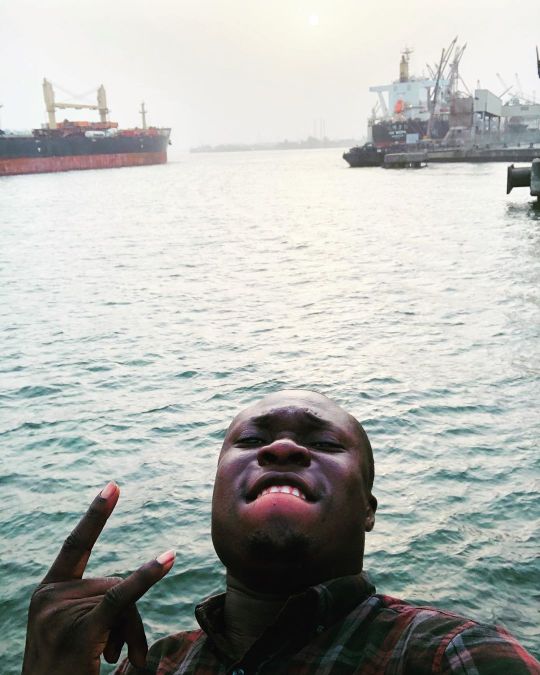
AM IN THE MIDDLE OF SOPHIE VICTORY AND KM WEIPA ~~~~~ AND AM LIKE, EVEN IF I DIVED IN, I KNOW SOMEHOW, SOMEWHERE, JONAH FISH 🐠 IS DOWN HERE TO TAKE ME TO THE NEXT SHORE.............~ #Figureofspeech ~ THIS #Shippinglines NEED TO PAY ME $50,000 FOR THIS RISK........ ~ MY NAME IS NEJO MICHAEL • • • #kmweipa #sophievictory #sailingvessel #shipper #carrier #transporter #merchants #importer #exporter #trader #seafarer #seafarers #merchant #captain #cruiser #cruiserboard #cruisedirector #cruiseship #cruiselife #oceanview #island #islandlife #islandliving #dockyard #ocean #voyager #travelling #traveller (at Life At Sea) https://www.instagram.com/p/B8tnNIZAG9j/?igshid=18aml8k1yhiic
#figureofspeech#shippinglines#kmweipa#sophievictory#sailingvessel#shipper#carrier#transporter#merchants#importer#exporter#trader#seafarer#seafarers#merchant#captain#cruiser#cruiserboard#cruisedirector#cruiseship#cruiselife#oceanview#island#islandlife#islandliving#dockyard#ocean#voyager#travelling#traveller
0 notes
Text
The Michael Bowden Memorial Bike Ride to The Tip of Cape York
August 2019
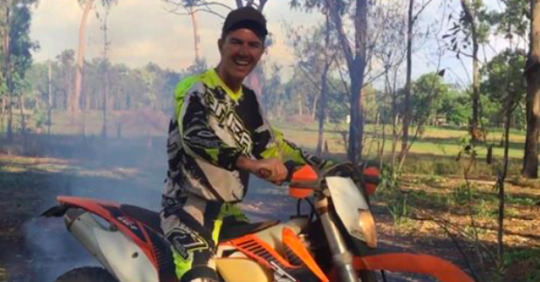
My grandson Micky
Cape York News 14 – 20 August 2019:
FRIENDS and family of Michael Bowden rode to the tip of Cape York earlier this month to pay tribute to the young man.
The 20-year-old died last year after he was struck by a vehicle on Northern Avenue on the opening night of the Weipa Fishing Classic.
With the court case against the alleged driver looming, the memorial ride provided the family and friends of Mr Bowden with an avenue to remember the joy that he brought to their lives.
“It was nice to be able to remove ourselves from the world and take the time to come together, remember the positive stuff about Mick, and turn our focus on starting to rebuild our lives,” family member Denica Russ said.
Mr Bowden and his brothers Mark and Brad loved riding motorbikes together. When the trio weren’t working as fitter and turners, they would often be on their bikes seeking out an adventure.
The Bowdens had joined the local GROWL (Geriatric Riders of Weipa Locality) club and enjoyed the camaraderie.
Riding the Old Telegraph Track to the Tip of Cape York was always a trip that Mr Bowden wanted to do. Before his sudden death, he went on what would be his last motorbike ride with GROWL up to Nolan’s Brook, seven kilometres back from the Jardine River.
Mark Coleman, the president of GROWL, was a part of the group.
“Mick loved the rides, but he particularly loved the rides that he did with his brothers,” he said.
“It wasn’t just about the riding for Mick. He always heavily involved himself with the group when they reached their destinations.
“This is the aim of our group – it is the whole deal – and Mick got that. This is what impressed me the most about Mick.”
Mr Coleman first met the Bowden brothers when working together at Rio Tinto.
“The three boys were very close, good tradesmen, and good riders,” he said.
“Mick was the last to join GROWL out of the three and he never rode outside of his capabilities.”
Mr Coleman and Mr Bowden’s brother Mark formulated the idea to do the memorial ride. When Mark Bowden contacted the rest of his family about the possibility of a memorial ride, the planning was quick and easy.
“When Mick’s family became involved it was the greatest thing ever,” Mr Coleman said.
“Mick’s parents Scotty and Rach are great people and the way they have bought their kids up is a credit to them.
“The three boys are all level-headed mature fellas for their age. They all have great work ethic, are not idiots, and everything they do is good compared to other kids that I come across.
“Mick was always smiling; a happy-go-lucky kind of bloke who loved life and his family.
“They had a unique bond.”
Mr Coleman and Mark Bowden were originally planning to ride to the east coast for the memorial ride, but chose to go to the Tip.
“Mick had been up that way not long before he passed away. The Telegraph Track is a gnarly adventure ride and is the big four- wheel drive trip on the Cape that brings adventurers up from all over the country,” Mark said.
“It was cool to bring my family up and go to the places that Mick had recently been to.
“This is an adventure that most of my family would never have imagined doing.
“It was a shame that Mick couldn’t be there with us, but nice we could do it. It was bittersweet.”
A lot of Mr Bowden’s family are from Charters Towers and Townsville. His parents Scott and Rachael live in Ravenshoe.
Together, everyone formed a convoy and road tripped to Weipa for the start of the memorial ride.
There were 44 of Mr Bowden’s family and friends on the trip.
Mark and Denica said: “Our family had a ball – my cousin Josh had hardly ridden a bike before, so this was a huge trip for him.
“Mum and dad bought the meat from the Tablelands and the GROWL club organised the rest of the food.
“I felt sad that Mark Coleman’s bike blew up before the trip and that his vehicle which transported a lot of the things we needed broke down on the way home.
“Without GROWL, this experience to help us move forward wouldn’t have been possible and we owe them so much.”
Mr Bowden’s uncle Aaron Schleich described the Cape York memorial ride as “very therapeutic”. “Since Michael’s tragic passing the family have only been able to gather for what would have been Mick’s 21st birthday, which was a big family get-together,” he said. Mr Bowden’s older sister Emily explained how she could feel her brother during the ride.
This was highlighted when Mr Bowden’s immediate family gathered to capture a photo standing at the Tip.
As everyone in the background were taking the photos, a pod of dolphins swam past.
They all agreed it was a special moment that created a memory for everyone to focus on.
However, Ms Bowden, who is already looking into the future for next year’s planned ride said: “How is Mick going to get in the next family photo when there will be no dolphins around?”
Mr Bowden’s family are looking forward to coming together each year and continue the memorial ride in different locations on the Cape in his memory.
Courtesy Melissa Diffo, Cape York News 14 – 20 August 2019
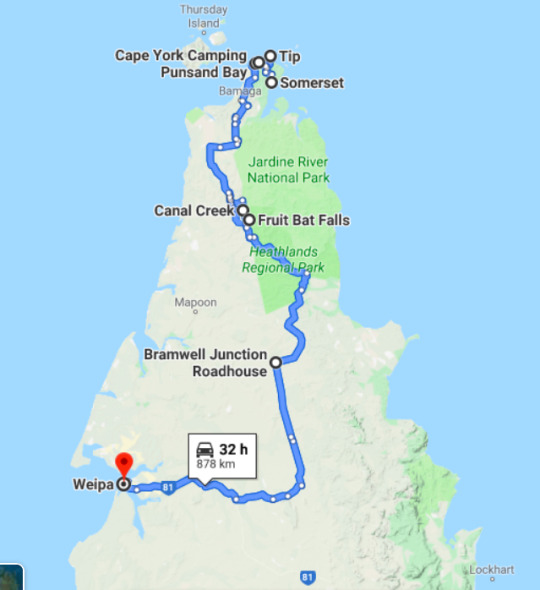
Map of the area
Travelling from Northern New South Wales, Charters Towers, Townsville and the Atherton Tablelands to join the Weipa crew, 14 riders, 18 adults, 12 children and three dogs made the epic journey (approximately 900 kilometres) across the remote, dusty, corrugated tracks of Cape York Peninsula. 4WD’s were kitted out, bikes loaded onto trailers and utes, food and eskys were already loaded up with provisions by the time I flew into Weipa late Wednesday. Many of the family had already journeyed far over dusty roads to reach Weipa.
Day 1: Thursday 1st of August
Weipa to Canal Creek
We departed Weipa early picking up a coffee-to-go at the coffee van on the way out of town and drove with all the bikes loaded east through Batavia Downs Cattle Station, past the Moreton Telegraph Station on the Wenlock River, to our meet-up point at Bramwell Junction Roadhouse.
By mid morning the bikes were unloaded and the riders kitted up for the southern section of the legendary Old Telegraph Track. Mark Coleman from the Weipa GROWL Club gave the riders a pep talk about what to watch out for and how the group would look out for each other. And off they went, bikes in one direction and we in the support vehicles continued on the Peninsula Development Road to meet up for lunch at Fruit Bat Falls situated in the Jardine River National Park.

Mark Bowden @ Bramwell, last minute preparations

Aaron Schleich set to go!

Wanna-be Cody practising for next time!
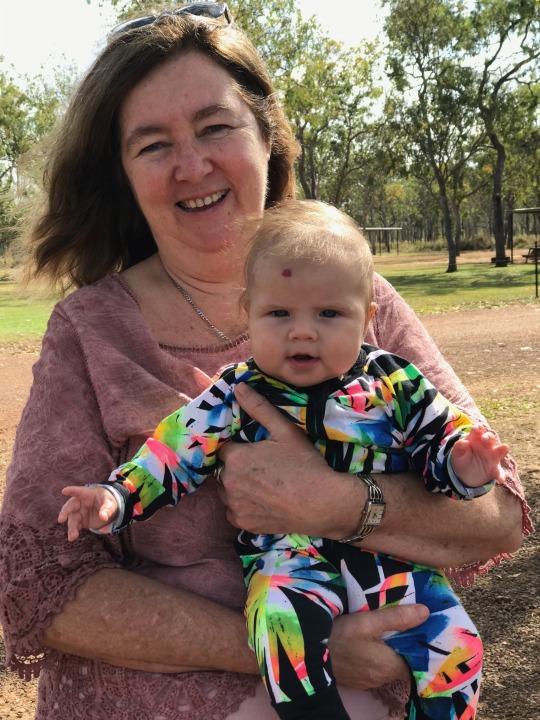
Great-Nanny Naj with baby Evie
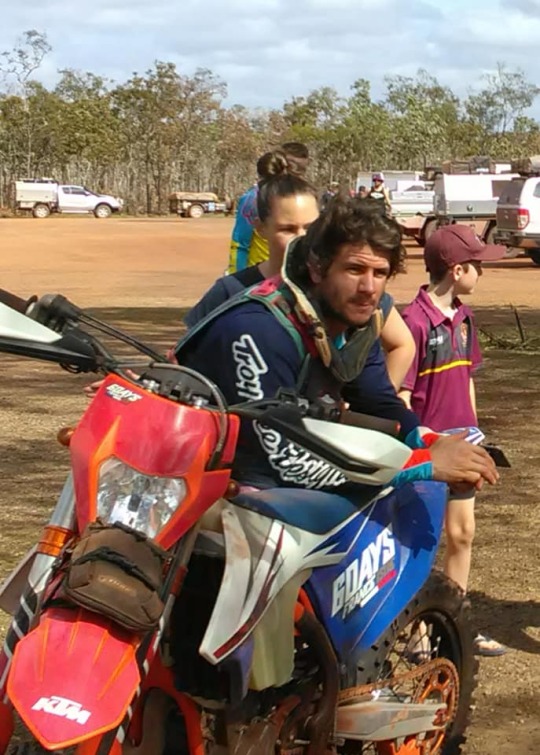
A pensive Brad Bowden
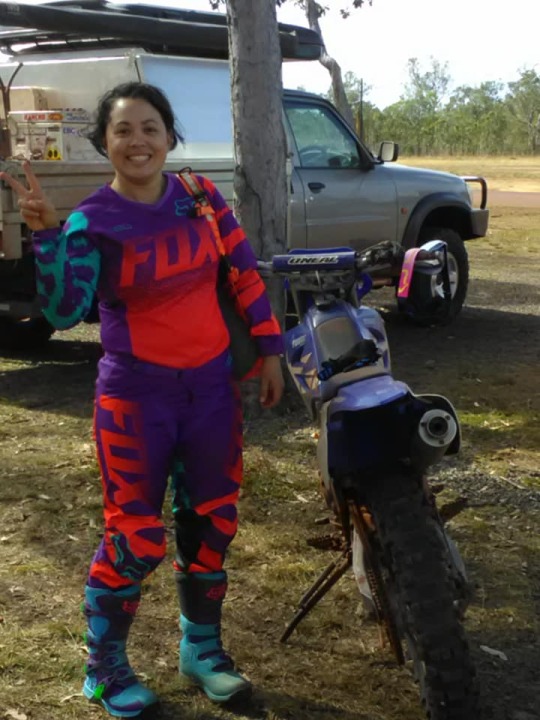
Denica Russ ready to go!
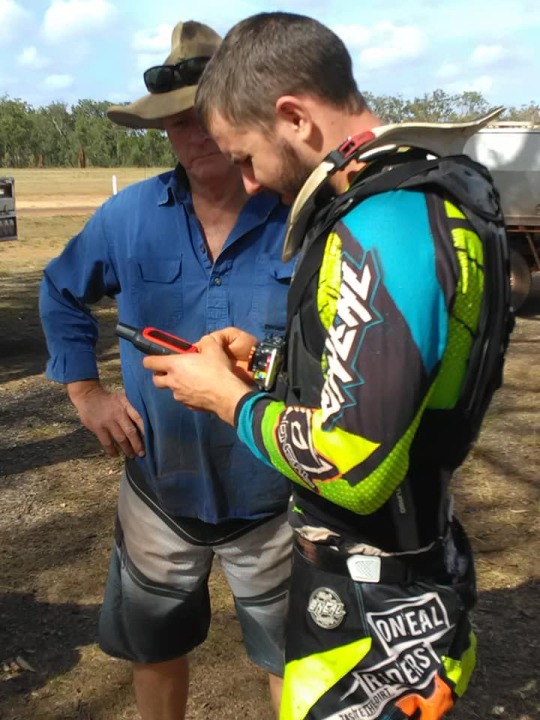
The two Marks. Mark Coleman is a veteran of these trips and his support was awesome!

Riders all kitted up for the first leg of the journey
The southern section of the Old Telegraph Track, which runs from Bramwell Junction to Bamaga Road, a distance of approximately 70Km, is an iconic drive that features eight challenging water crossings and some stunning tropical scenery as you head north towards the Tip of Australia.
Telegraph Line History
In the early 1880s the Queensland Government had JR Bradford, Inspector of Lines and Mail Route Services, survey a route along the Cape York Peninsula to Thursday Island for the construction of an electric telegraph line. Finally, after three gruelling months, the expedition reached Somerset: near the northern tip of the Cape.
Work on the Cape York Peninsula section began soon after and was completed in 1886, except for 90km between Moreton and Mein where telegrams were carried by horse and rider until the line was completed. The line consisted of galvanized cast iron ‘Oppenheimer’ poles manufactured in Germany and many are still standing today. Ceramic insulators are also sometimes found. After more than 100 years of service, the line was closed in 1987.
(Courtesy www.hemamaps.com)
The support vehicles were the first to arrive at Fruit Bat Falls picnic area and we enjoyed a picnic lunch and swimming in the crystal clear waters.


Evie greets Poppy at Fruit Bat Falls
Finally the riders arrived, and there already had been some injuries: Brad hit a small tree and went over the handlebars injuring his shoulder quite badly - no blood but internal damage - no more riding for him today, and Josh came off at one of the creek crossings injuring his foot and a finger - he kept his boot on and rode the rest of the way but he only found out a week later that both the finger and the foot were fractured.
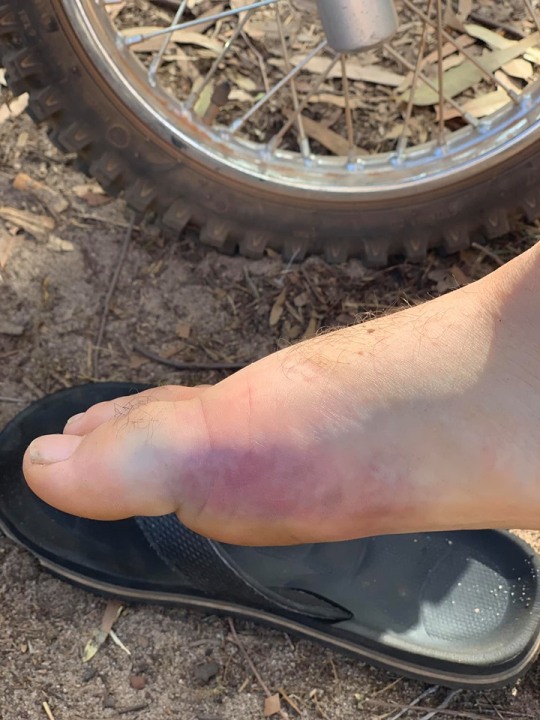
Ouch!
The injured had some hydrotherapy at Fruit Bat Falls, and with belly’s full we all then headed down the four wheel drive track to nearby Canal Creek to camp the night. It was the best spot to camp being situated just outside the national park so we were able to have an open fire and the dogs could have a bit of a run around.

Micky’s dad Scott rode Micky’s bike - he made it unscathed!
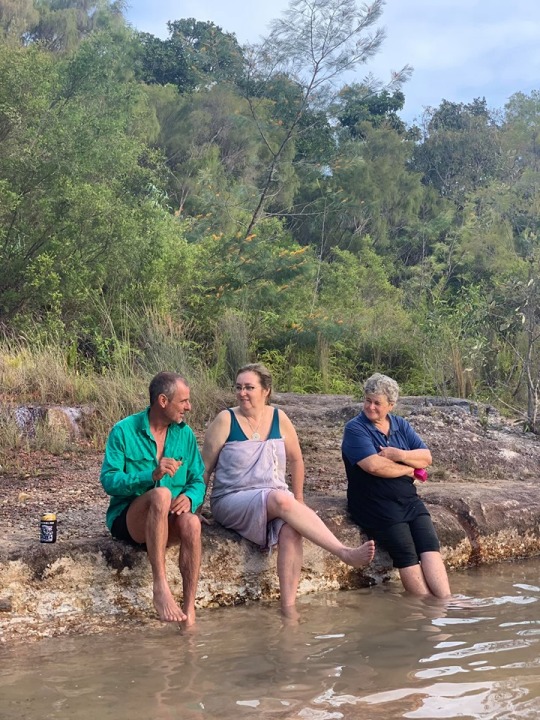
Scott with his mum Sue and “the mother-in-law” by the edge of Canal Creek
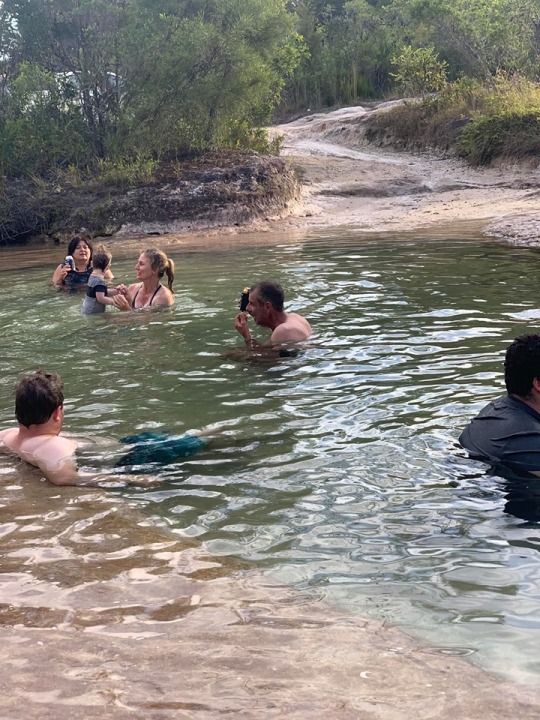
Chillin out at the end of the day!

Ron and Sue taking a dip!

Uncle Glen, Uncle Aaron, Cousin Josh & Kim enjoying the cool water
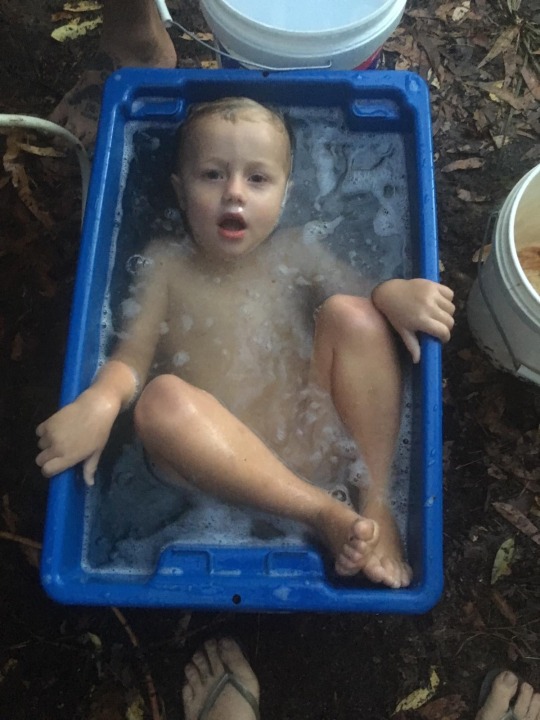
Cody enjoying his camp bath!
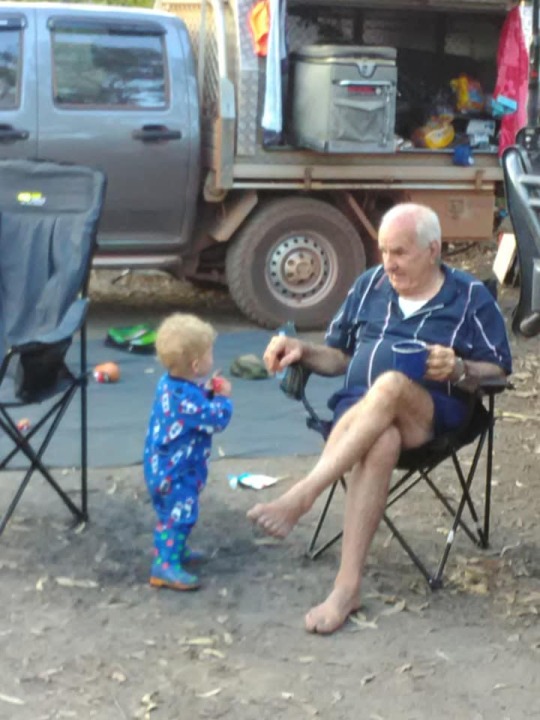
William with Great Grandad!

Canal Creek camp - Mark Coleman on the BBQ - the Growl Club provided dinner for this first night.
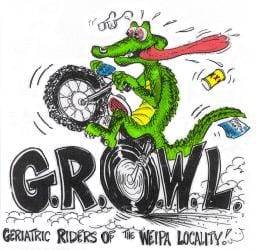
Day 2: Friday 2nd of August
Canal Creek to Punsand Bay The day started with a camp breakfast courtesy of Growl, and bikers rode more of the Telegraph Track to our next meet-up spot at the Jardine River ferry crossing, while the cars drove via the bypass road. There were a few changes - Glen took over from Scott riding Micky’s bike, and Denika handed over her riding gear to Micky’s sister Emily who regarded herself as a novice rider. However with lot’s of family looking out for her she was keen to have a go.
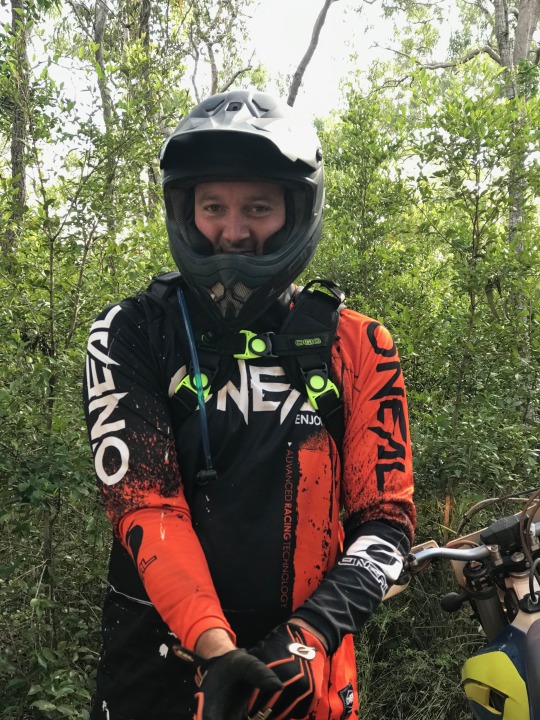
Aaron is keen to get going!

Beau, Eli and Cody - “Let’s go!”

Denica all prepared for the next leg of the trip to Punsand Bay
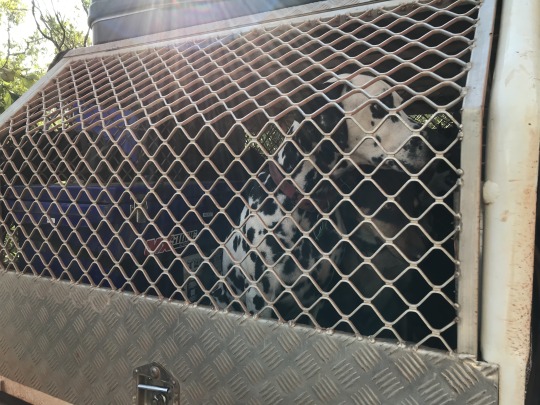
Leonard and the other dogs are ready too!

Emily ready to ride!
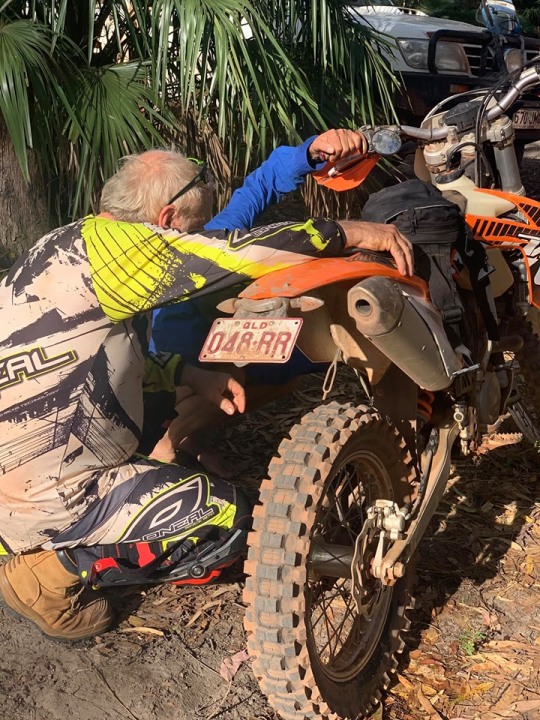
Glen and Scott - bush mechanics!
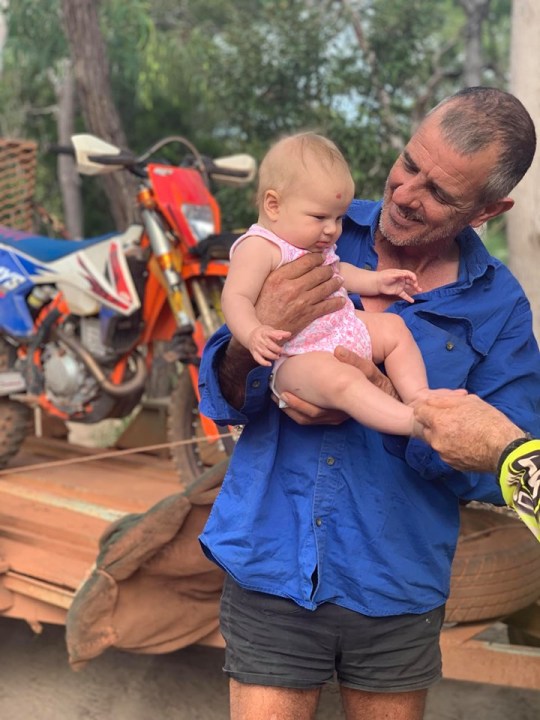
Evie got lots of cuddles while mum and dad packed up the car ....
Before leaving the Jardine River National Park, we made a short stop at Twin Falls where Micky had spent the weekend before his tragic death. Twin Falls is a series of rock pools and cascades that is linked by tracks and boardwalks to nearby Eliot Falls.

Enjoying the crystal clear waters at Twin Falls

A pensive Grandad Ron remembering Mick
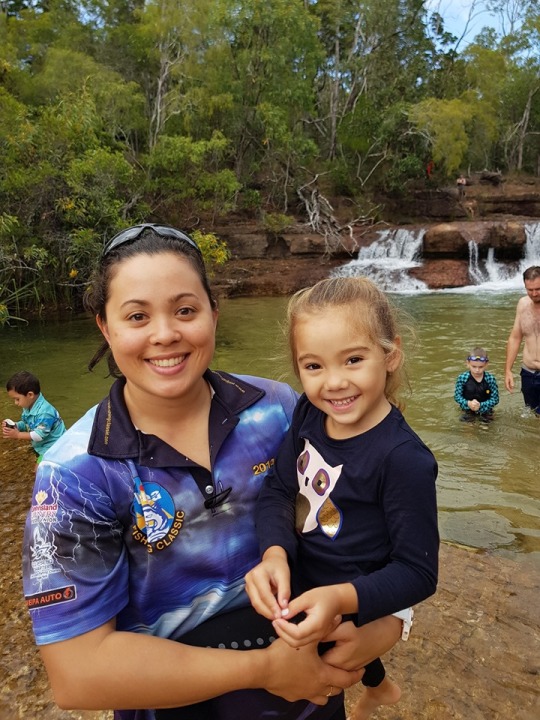
Tillie with Auntie Denica
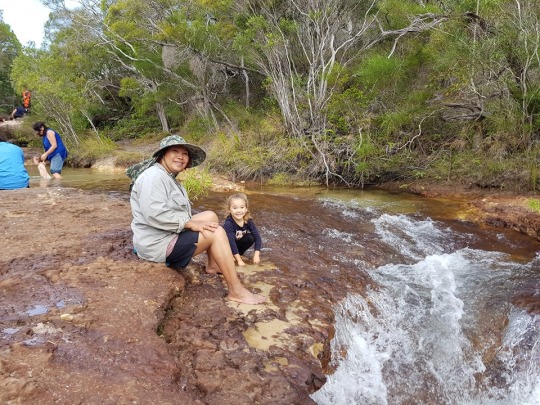
Nana Emma Russ with Tillie
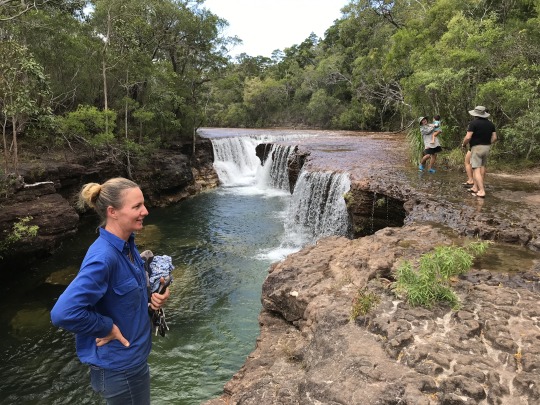
Micky’s mum Rachael enjoying a quiet moment before getting back on the road
Leaving the National Park was another matter! Lucky we spent some time at Twin Falls - the driver at the head of this line of cars had been waiting for 1.5 hours! It was reassuring to have these workmen on hand as we climbed out of this crossing!
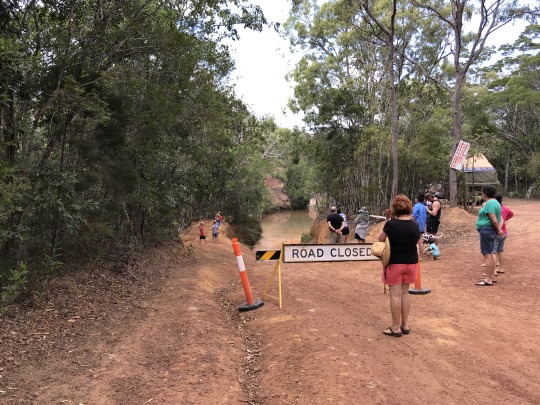
Oh no! This is our only way out!

The little boys enjoyed watching the workmen at work!
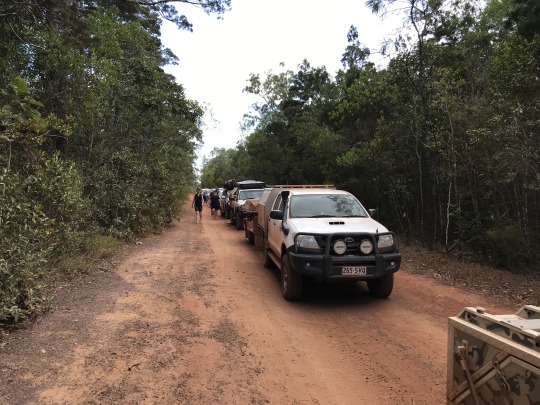
There were more than a dozen cars waiting to cross this creek - some had been waiting over an hour!
The riders on the other hand went in the other direction down the Telegraph Track to tackle even more challenging creek crossings .....
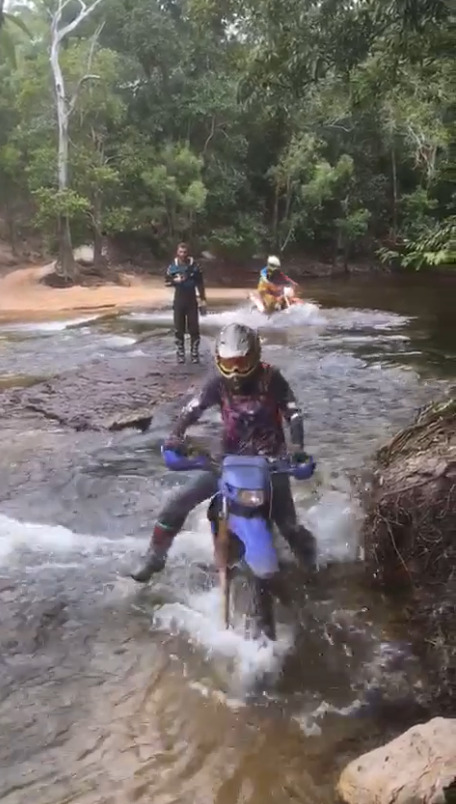
Emily doing it like a pro!

Rob Moore following up behind
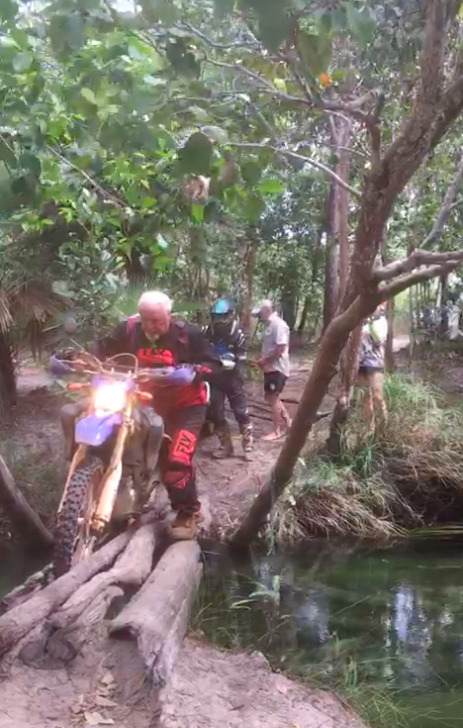
Glen walking Micky’s bike across this tricky crossing!

Crossing the Jardine
Once at the Jardine, anyone who was not registered or licensed had to load their bike up and travel in the cars to Punsand Bay camping ground. Tickets for a single vehicle return is $100, and if you are towing a caravan it is even more.
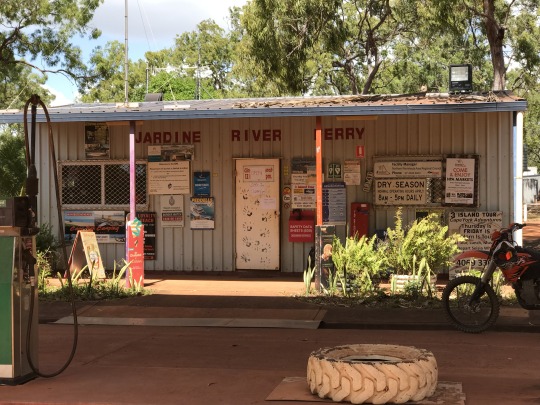
Buy your tickets here, but closed for lunch from 12 to 1.

Loaded ferry
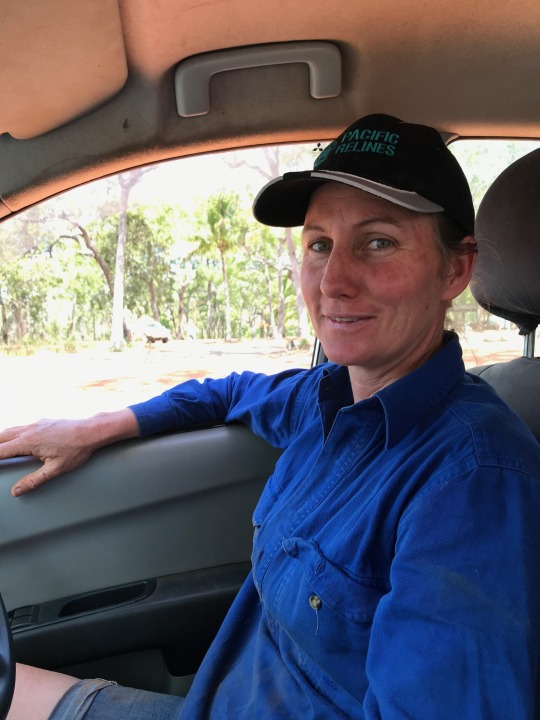
A confident Rachael towing a trailer full of dirt bikes waiting to cross
Crossing the Jardine we enter the Northern Peninsula Area. The NPA Region is made up of five indigenous communities. There are three aboriginal communities: Injinoo, Umagico and new Mapoon, and two Saibai Islander communities: Seisia and Bamaga.
Saibai Islander people were forced to relocate in pursuit of fresh water and land, and they resettled at the site of the old Red Island Wharf in Seisia. The name Seisia is made up from the first letter of each of the brothers Sagaukauz, Elu, Ibuai, Sunai, Isua and Aken, the founding brothers of the community. Seisia wharf provides the region with shipping and ferry services, as well as being a popular local fishing spot, offering beautiful sunsets and views of small islands across the water. Of course many crocodiles, sharks and stingrays inhabit these waters.
We stopped for lunch at Sesia, topped up with fuel and ice before turning north at Bamaga for the final leg to Punsand Bay.
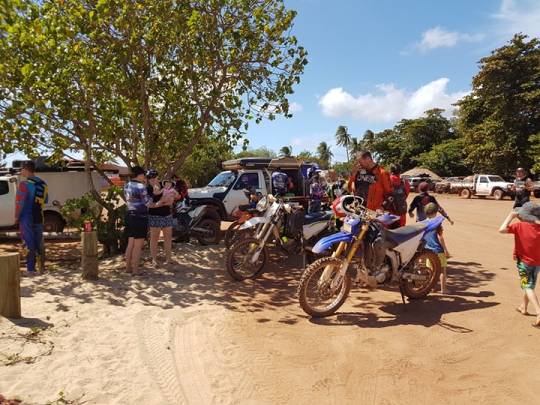
Lunch in the shade at Seisia
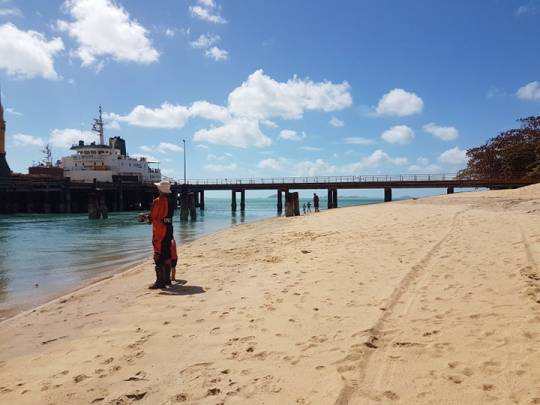
A hopeful Aaron fishing at Seisia - SeaSwift ferry tied up at the wharf

Cape York sign!

Hot showers and cold drinks! YES!!!
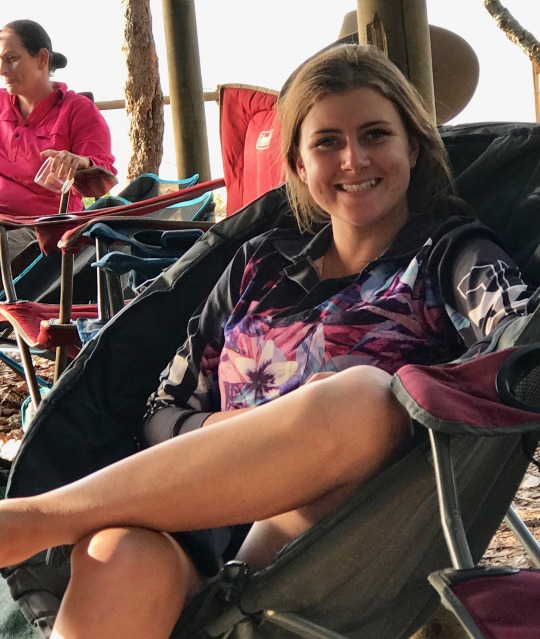
Emily relaxing after a satisfying day
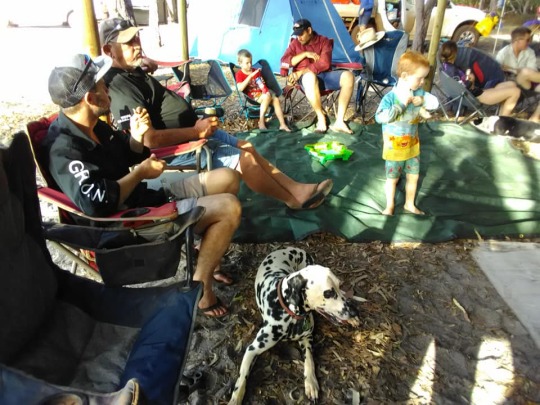
The GROWL camp at the end of Day 2. Mark cooked up a huge pot of prawns which everyone loved. Thanks Mark and Eileen!

My camp site under the trees and view to the sea - one happy camper!
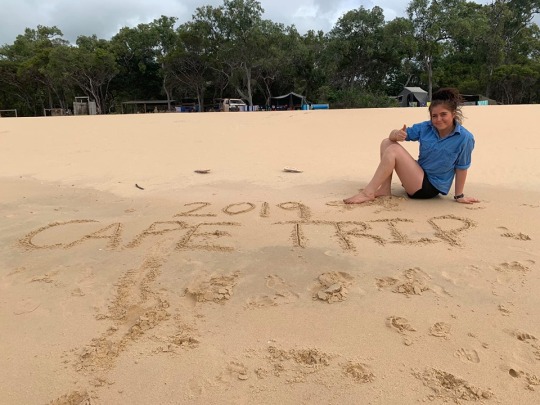
Hayley Bowden at Punsand Bay
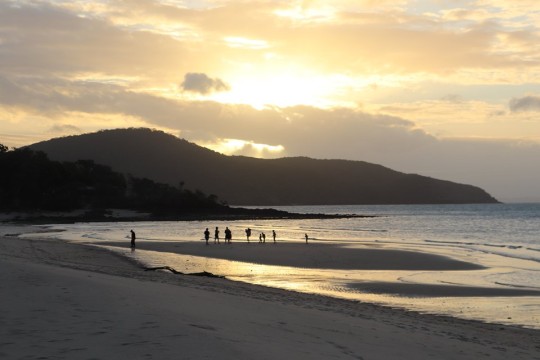
Sunset at Punsand Bay

This is the life!
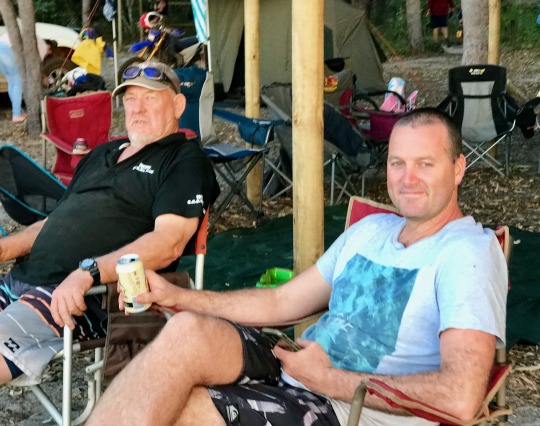
Aaron enjoying sundowners @ Punsand Bay
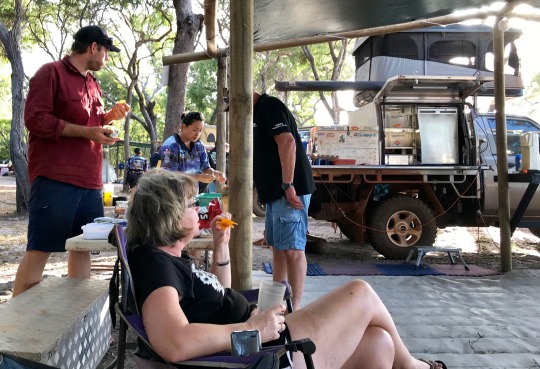
Eileen enjoying the afternoon ambiance
Day 3: Saturday 3rd of August
The Tip of Cape York, Somerset, and the 5 beach trail ride
Today is the culmination of our trip to The Tip with us all donning our Micky Memorial shirts and the boys taking Michael’s bike to the northern most point for a photo with us all.

The cairn of rocks in the middle distance is man-made by the hundreds of walkers who each add a rock to the pile as they go past.
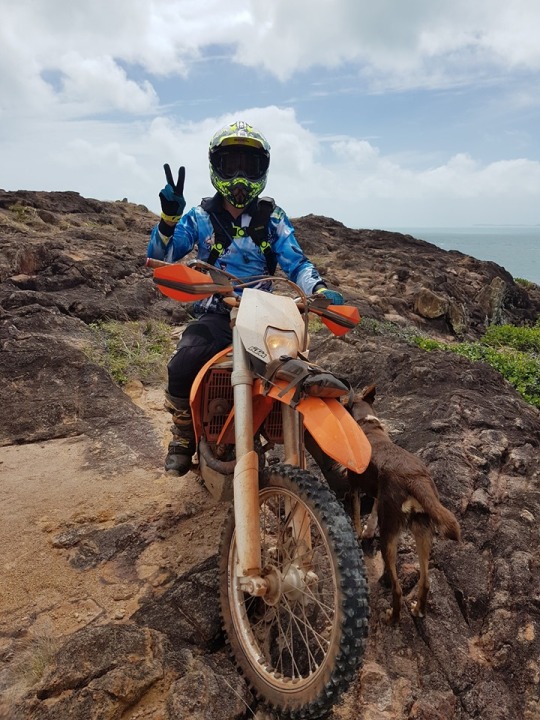
Mark Bowden riding Micky’s bike to The Tip
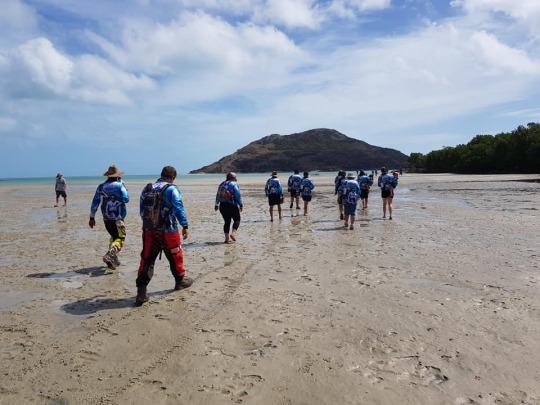
It was low tide so we were able to walk along the beach some of the way
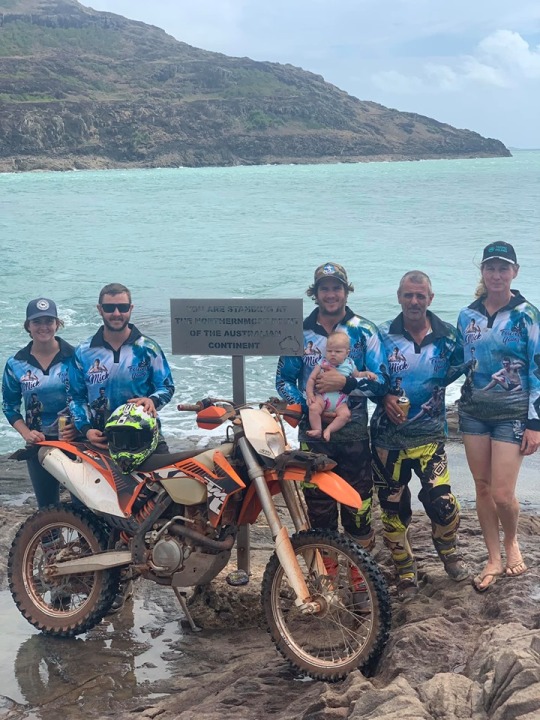
Micky’s immediate family
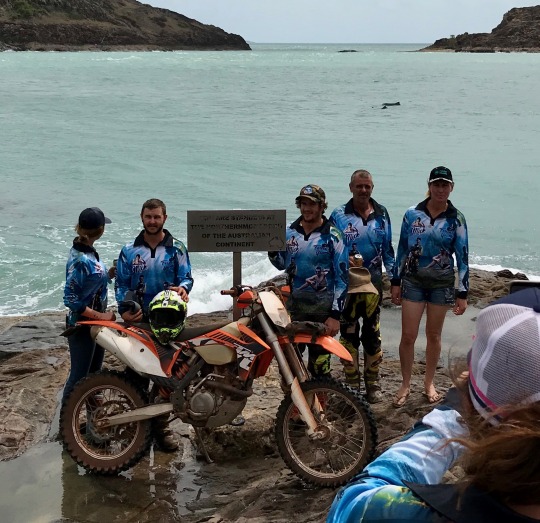
"As everyone in the background were taking the photos, a pod of dolphins swam past.” We decided this was Micky’s way of saying he was with us!
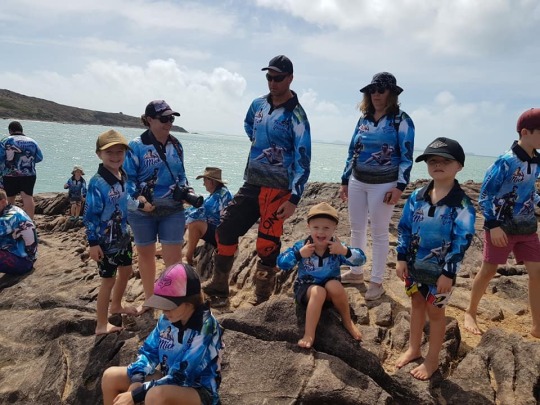
The Schleich crew!

All of us with Micky’s bike and helmet at the northernmost point of the Australian mainland.
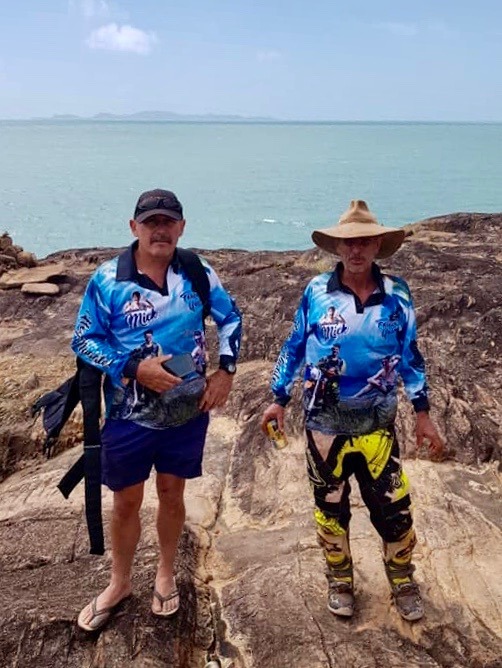
Russ and Scott - Evie’s two “Poppies”!
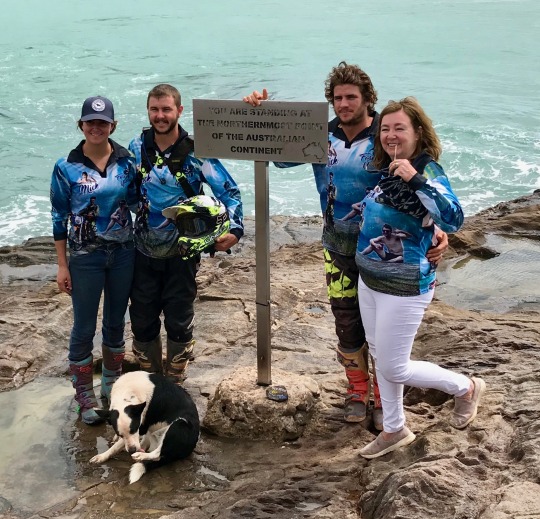
Granny Naj with Emily, Mark and Brad
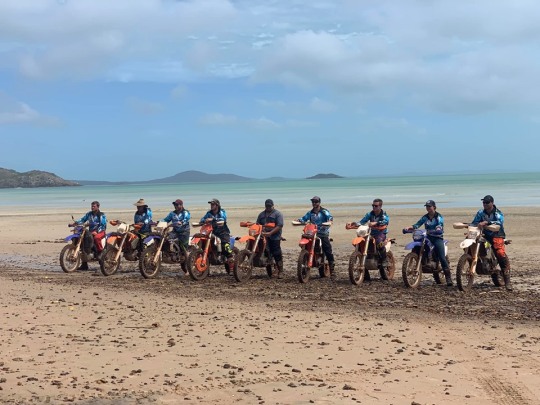
Riders once again lined up in a salute to Mick, before heading off for more adventures
We picnicked at historic Somerset beach on the eastern side of the Tip.
History of Somerset
John Jardine had migrated to New South Wales in 1840, and held a number of government appointments before being made Police Magistrate and Commissioner of Crown Lands at Somerset, at the tip of Cape York Peninsula, in 1864.
In 1865, 22-year-old Frank Jardine, his brother Alexander and eight others drove a mob of cattle overland from Rockhampton to Somerset, a remarkable feat which made them heroes in colonial Queensland.
They started with 42 horses and 250 head of cattle. The trip took 10 months during which time the party was constantly opposed by the area's inhabitants as they forced their way through scrub and swamps and crossed at least six large rivers, including the Jardine River which was subsequently named after him. They reached Somerset on 2 March 1865 with 12 horses and 50 cattle. Jardine's men survived, in poor health; they left a trail of dead Aborigines, dead horses and cattle and all their equipment.
For their pioneering exploratory efforts the Jardine brothers were made Fellows of the Royal Geographical Society and awarded the Society's Murchison Award in 1886.
Frank Jardine became in effect a law unto himself in northern most Queensland and is reputed to have been extremely cruel and barbaric.
The local Indigenous population was dispossessed and there was hostility between them and the Jardine family, both during Frank and Alick Jardine's expedition to Somerset, and during the years of the settlement. Jardine was also suspended for a time from his duties as Police Magistrate whilst being investigated in relation to using his position to obtain a pearl diving licence.
In 1873, Jardine married Sana Solia, the seventeen-year-old niece of the King of Samoa. They had two sons and two daughters, and the marriage endured until Jardine’s death from leprosy in 1919. Their graves can still be seen here at Somerset.
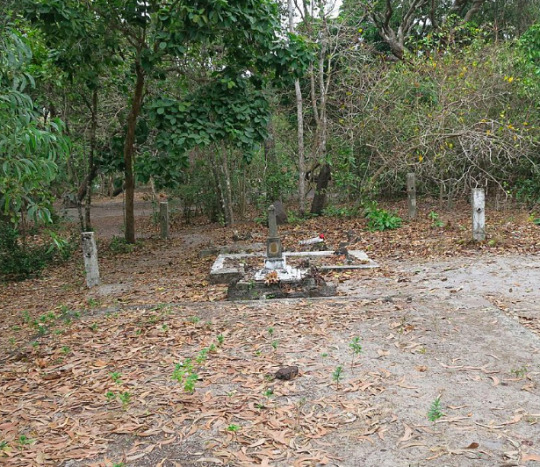
The pearl diving industry was important to the Queensland economy, and came to be dominated by Japanese divers after 1891. Kobori Itchimatsu came from the village of Nishi Mukai in Wakayama prefecture, an area that provided 80 per cent of the 7,000 Japanese who left their country to become pearl divers.

The earliest known burial was that of Cancan, a pearl diver, dating to 1890. Japanese pearl diver Kobori Itchimatsu was also buried there in 1909. Both graves are situated in the north area of the site.
Several Indigenous groups occupied this region prior to European contact. In an 1896 report to the Queensland Government, Archibald Meston estimated that in the 1870s the Indigenous population between Newcastle Bay and Cape York was around 3,000. At the time of writing his report, he believed that the population had fallen to around 300. This rapid decline was caused by a number of factors, including introduced disease, exclusions from traditional hunting grounds and frontier violence. Reverend Frederick Charles Jagg, a missionary at Somerset appointed by the Society for the Propagation of the Gospel, gave an indication of the relationship between European and Indigenous peoples when he reported in 1867 that "The aborigines have been described as the most degraded, treacherous and bloodthirsty beings in existence by the present Police Magistrate, and those whose only idea is to shoot them down whenever they were seen".
Somerset became redundant as a port once a safer shipping route to the Torres Strait was found and a settlement on Thursday Island was built from 1876. Frank Jardine continued to live at Somerset, maintaining the police residence until his death there in March 1919. During this time, Jardine continued to maintain a beef cattle herd; was engaged in the pearling industry; and created a coconut/copra plantation at Somerset.
Due to Somerset's isolated location the Jardine family provided assistance and hospitality to travellers and seafarers, for example, Jardine aided the survivors of the shipwreck of RMS Quetta in 1890.
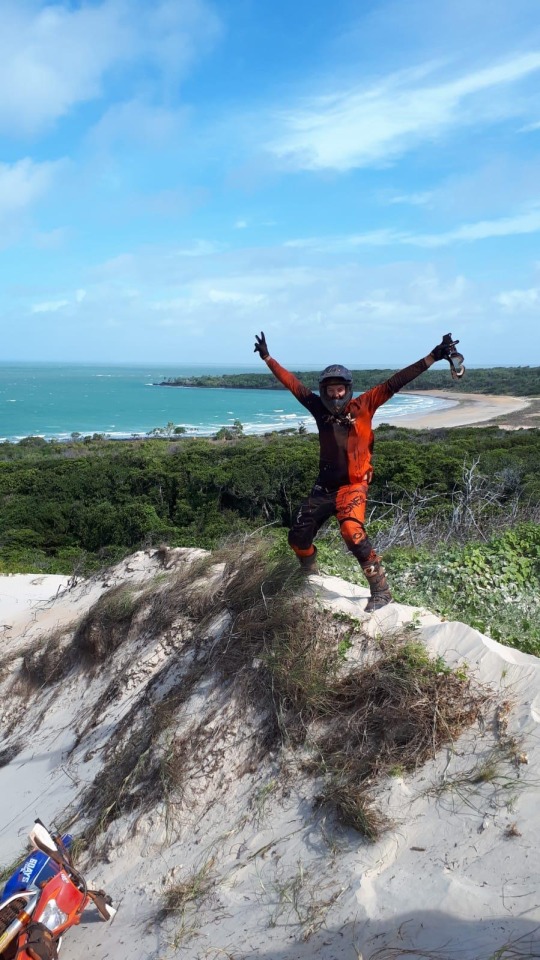
Aaron conquering the five beach trail ride on the eastern side of the Cape overlooking Freshwater Bay.
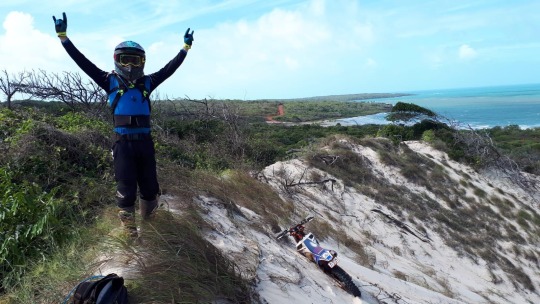
Remote and tricky - one rider did not make it, his bike seizing up in the excessive sand hills.
While the big boys were exploring the dunes, the little ones had fun riding up and down this remote sandy shoreline.
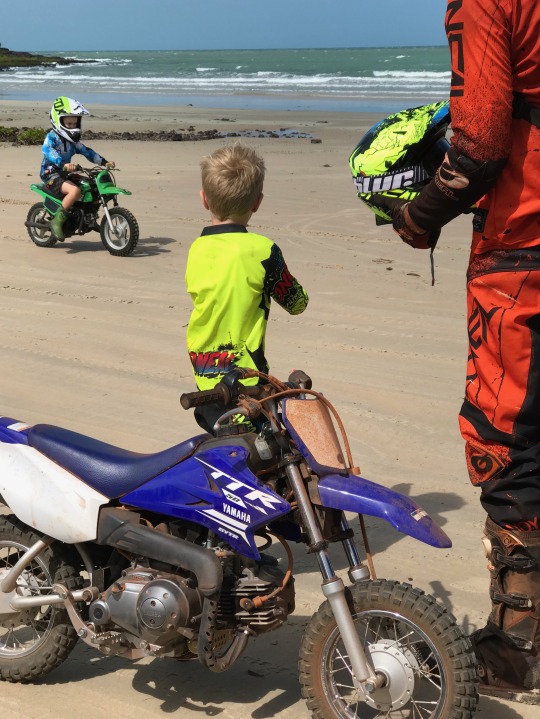
Beau getting ready to ride

Helmet: check; Gloves: check ....
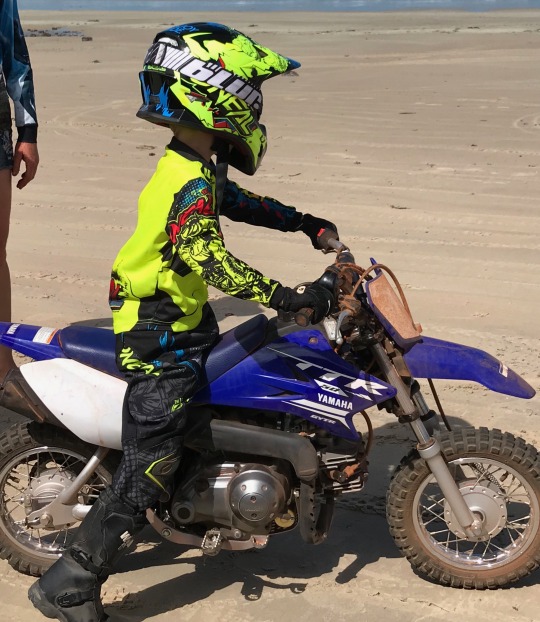
Go Beau!
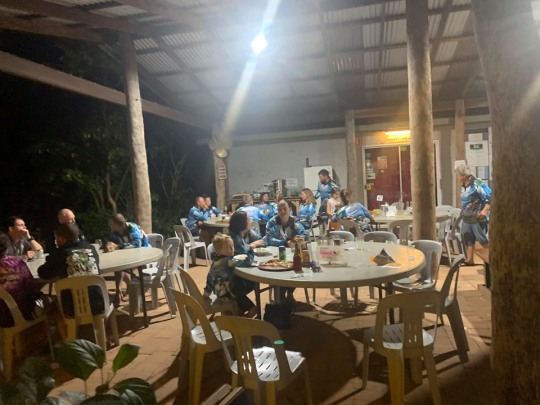
Dinner Saturday night at Punsand Bay with us all wearing out Micky Memorial shirts. Tourists to the area were curious and a few came over for a chat. Day 4: Sunday 4th of August
Punsand Bay to Bramwell Station
We de-camped and got away reasonably early and met up with the riders on the southern side of the Jardine River Ferry, then we drove in convoy to Fruit Bat Falls for our final lunch together. The wind was blowing a gale so jumping in the water was not so inviting. Scott gave a wonderful speech thanking everyone for coming, and proposing that we do it again next year - at a different location though. Everyone thought it was a great idea.
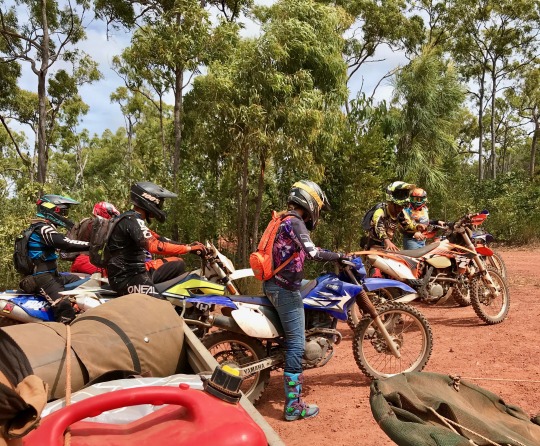
The riders once again tackled the Old Telegraph track, this time including Emily who by now had become an experienced rider, and crazy Josh, who, despite his broken foot, chose to once again ride this treacherous stretch of road .... well, more a track than a road! Mind you he still did not know it was actually broken!
Next stop was the campground at Bramwell Station.

Setting up camp at Bramwell Station

Sunset on Bramwell Station
Normie Rowe and The Bagman were performing the night we were there. The restaurant was booked out but we were able to wander up and enjoy the concert. The young ones thought that Normie was a bit old hat, but Bagman brought the house down with his bush poetry. Tears of laughter!
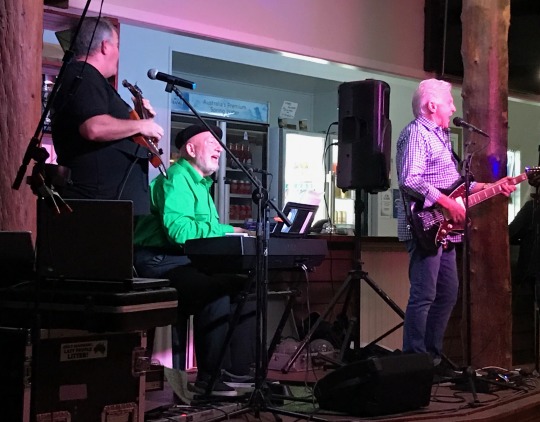
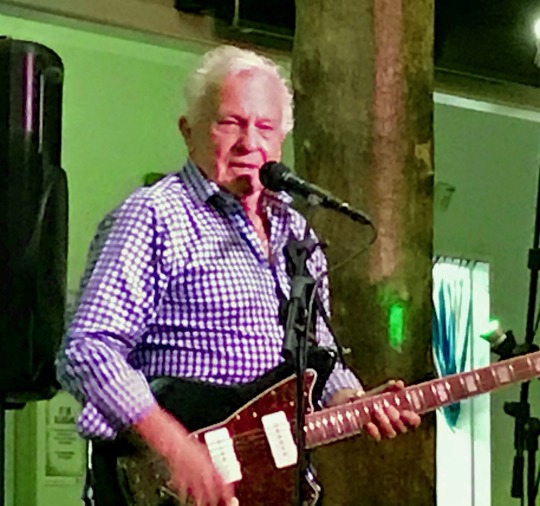
Normie Rowe
Day 5: Monday 5th of August
Bramwell Station to Weipa
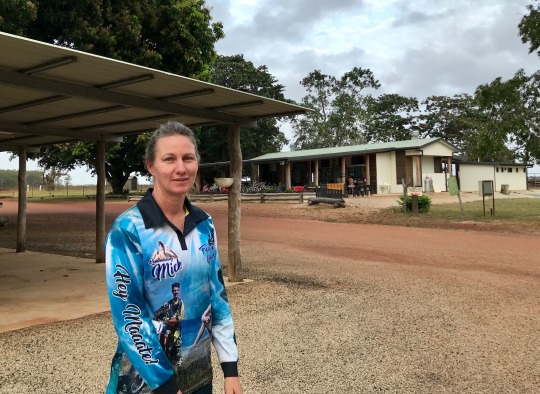
Rachael with the Bramwell Station restaurant and bar in the background
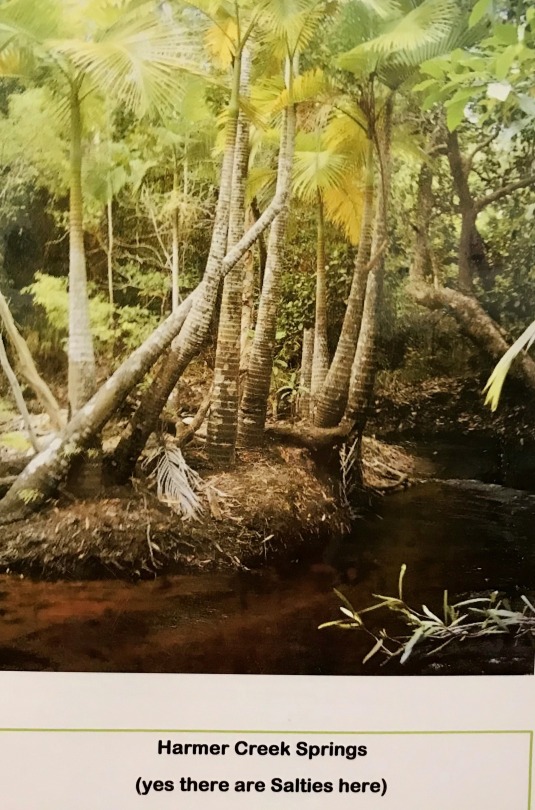
Photos from Bramwell Museum
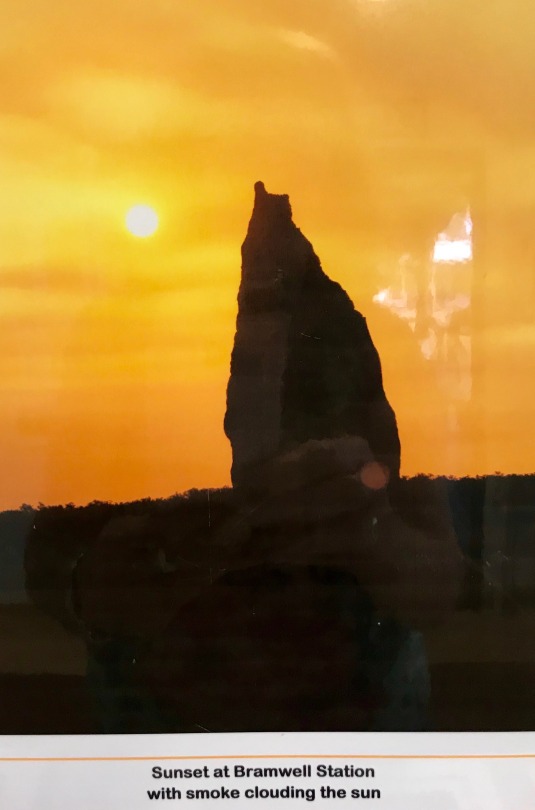
Photos from Bramwell Museum - these huge termite mounds are a typical feature of the Cape York scrub

Photos from Bramwell Museum The Cuscus is a marsupial unique to Cape York.
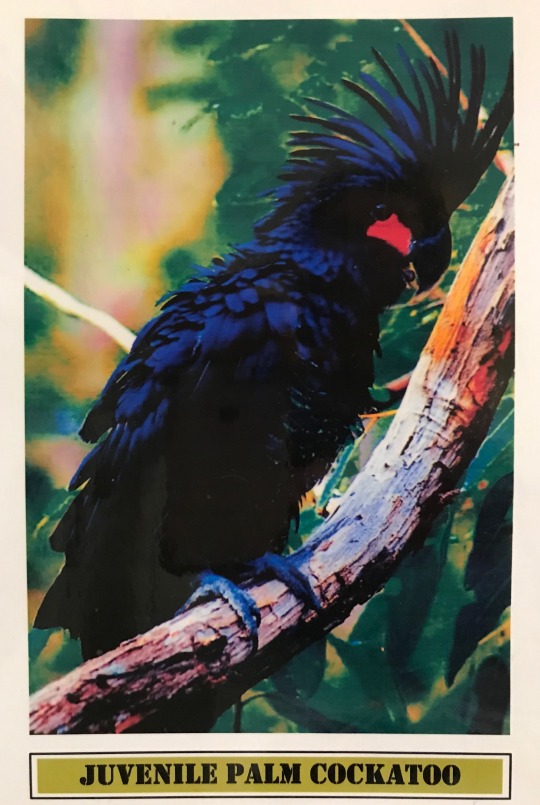
Photos from Bramwell Museum - the largest cockatoo in the world! It is sacred to indigenous tribes.
And here we end this epic saga. Bramwell is just two hours drive from Weipa where the journey ended on Monday lunchtime, time for Emily to pack and board her flight to Brisbane. The Charters Towers mob and Ron and Sue continued driving south rather then returning to Weipa, while Scott & Rachael, Mark (headed for Cairns), Brad, Ash, her dad Russ and baby Evie (headed for Townsville) all departed early Wednesday. But not before Scott had sampled his favourite meal in Weipa - Sizzling Duck at the Thai restaurant on Tuesday night ..... one more time to all be together before heading our separate ways. No pics I am sorry! As Peter Cundel used to say: That’s your blooming lot!
Thanks everyone for making this trip so memorable!
Until next time .......
0 notes
Photo

@jharalyowyeh5 getting bent on his trip up to Weipa! #TroutJersey #DeepBlueSnapback #tideapparel #seeaustralia #fishing
2 notes
·
View notes
Text
CAPE YORK ON A BUDGET - Part 3 of 8
New Post has been published on https://www.4wdsupacentre.com.au/news/?p=524
CAPE YORK ON A BUDGET - Part 3 of 8
This is part of a series of articles about how to have TWO EPIC WEEKS IN THE CAPE FOR $1500! If you haven’t read the first part we recommend heading back to Part 1 and reading through for an absolute cracker of a time up in wild and wonderful Far North Queensland!
DAY 5: BATHURST HEAD TO ARCHER RIVER ROADHOUSE
One of our favourite things about Cape York is pulling into a roadhouse every couple of nights for a cold beer and a hot shower. Everyone’s there having an absolute ball, sharing stories and advice and camping together. Archer’s got a beaut grassy, shady campground which is a nice change from camping on the dirt and the sand out in the scrub. Top up the tank of an arvo so you can get an early start in the morning without waiting in line.
Distance travelled: 170km
Rough fuel cost: $50
Camping fees for the night: $10/person per night
DAY 6: ARCHER RIVER ROADHOUSE TO PENNEFATHER RIVER
Weipa’s the biggest town on the west coast. It’s largely a mining town but it must be one of the most picturesque mining towns anywhere in Australia! It’s about three hours up into Weipa from Archer River, so you should roll in late morning. Fuel up, grab any tucker or camping supplies you need from town and then point north towards Mapoon, keeping an eye out about 40km north of town for the turn-off to Pennefather Beach. When you get to the beach, you’ve got two choices – a run up the sand (it’s bloody soft) or the tracks on the back side of the dunes which can be a bit boggy (avoid the water holes) and closed over with lantana. Either way, the reward is the mind-blowing camping where you can unroll a Swag or unfold your Rooftop Tent right on the mouth of the Pennefather River. Epic fishing too!
Distance travelled: 70km
Rough fuel cost: $40
Camping fees for the night: $0
DAY 7: PENNEFATHER RIVER TO FRENCHMAN’S TRACK
Here it is – the legendary Frenchman’s Track. You can do it in either direction but we like to avoid doubling back on ourselves wherever possible so head south on the PDR til you get to the Lockhart River turn-off, then keep a really good eye out on the VMS 700HDX Offroad GPS for the un-signposted turn off left to the start of the Frenchman’s. There’s two crossings on this track – the Pascoe, which is deep, fast-flowing and should be approached with extreme caution – and the Wenlock, which is wider, sandier and a perfect camp for the night. There’s a nice little spot at the top of the northern exit to the crossing that’s flat and grassy.
Distance travelled: 250km
Rough fuel cost: $70
Camping fees for the night: $0
To be continued…
0 notes
Text
‘My Country’ by Mavis Ngallametta
‘My Country’ by Mavis Ngallametta
Indigenous Art
Jessica Booth and Laetitia Prunetti
Artist Mavis Ngallametta in front of ‘Kendall River’, 2012. Photo – Martin Browne.
Mavis Ngallametta, ‘My Country – Kendall River‘ , 2017, natural ochres and charcoal with acrylic binder on linen, 201 x 272cm. Photo – courtesy of the artist and Martin Browne Contemporary.
Mavis Ngallametta, ‘Low Down Swamp’ 2016, natural ochres and charcoal with acrylic binder on linen, 270 x 199cm, and ‘Pundum’ 2016, natural ochres and charcoal with acrylic binder on linen, 270 x 199cm. Photos – courtesy of the artist and Martin Browne Contemporary.
Mavis collecting white ochre, Ikalath. Photo – Martin Browne.
Mavis Ngallametta, ‘End Swamp’ 2017, natural ochres and charcoal with acrylic binder on linen, 201 x 272cm. Photo – courtesy of the artist and Martin Browne Contemporary.
Mavis Ngallametta, ‘Swampy Area at Yalgamungken’ 2017, natural ochres and charcoal with acrylic binder on linen, 272 x 201cm, and ‘Small Horse Creek’ 2017, natural ochres and charcoal with acrylic binder on linen, 272 x 201cm. Image courtesy the artist and Martin Browne Contemporary. Photos – courtesy of the artist and Martin Browne Contemporary.
Mavis Ngallametta’s large-scale paintings, a selection of which are currently being exhibited at Martin Browne Contemporary in Sydney, are both derived from, and imbued with, the material richness of her natural environment. Incorporating white ochres from the cliffs of Ikalath on the west coast of the Cape York Peninsula, mixing fecund greens from a combination of yellow ochre pigment and charcoal – Mavis is both a master colourist and an alchemist of sorts. Her bountiful and interwoven depictions of the waterways, geological formations and flora around Aurukun show her to be a painter of great vision and complexity.
Aurukun is a community on the north-west coast of the Cape York Peninsula in Far North Queensland. Over 800 kilometres west of Cairns and almost 180 kilometres south of Weipa, it is what many of us would call a remote, isolated place. It is also Mavis’ home, and the source of both her subject matter and painting materials.
Like a number of prominent female Indigenous artists, Mavis began her career as a weaver. Taught by senior Wik and Kugu women on country and at the mission school, she became proficient in, and renowned for, creating mats, baskets and dilly bags from cabbage palm and pandanus. In 2009 she became involved with Ghost Nets Australia, a movement spearheaded by Indigenous communities to bring attention to the plastic fishing nets killing marine life and making landfall on beaches around Northern Australia. The project eloquently marries artistic and environmental concerns in the creation of beautiful sculptures woven from discarded nets. In 2008 Mavis began experimenting with painting, participating in a workshop at the Wik and Kugu Art Centre run by facilitator Gina Allain. Relatively quickly, she began working in two dimensions with natural ochres and charcoals.
Whilst not prolific – she has completed less than 40 large scale paintings in the last seven years – Mavis’ output has been impressively consistent in terms of quality (almost a quarter of those works have been acquired by public institutions such as Queensland Art Gallery’s Gallery of Modern Art, National Gallery of Australia, and the Art Gallery of NSW) and artistic vision. Despite her success, Mavis’ achievements have been quietly won – her luscious, multi-layered works are still unknown to many.
Mavis depicts her traditional country of Kendall River, but also draws inspiration from other places around Aurukun where she lives. ‘At the moment I love painting the swamps and swampy areas’, Mavis says, in conversation with Gina Allain. ‘If you come to Aurukun you will see lots of swamps with a lot of water lilies, lots of birds and lots of different coloured swamp flowers.’ Swampy Area at Yalgamungken 2017, from Mavis’ current solo show, depicts the flowers and birds that appear at the end of the dry season at Yalgamungken, where she collects her yellow ochre.
Works begin with a blue acrylic base colour, the blue of the Arafura Sea surrounding Cape York. From there, the painting is made from the landscape. Mavis says: ‘I can make many colours from the yellow, red, black and white [ochres]… I mix the yellow ochre with the black…from the charcoal and I get greens. I mix the red and yellow and I get oranges. If I mix the white clay with the red ochre, I get pink. I cook the yellow ochre to get the red. Depending on the length of time you cook the ochre, and the colour of the yellow that I have collected, it makes different shades of red.’
Her environmental concerns, so powerfully expressed in her ghost-net weavings, are present in Mavis’ paintings too: the fishing nets and oil drums that wash up on the beach at Aurukun are sometimes incorporated into her densely painted compositions. The presence of this unwanted debris is jarring alongside wetlands in full flourish depicted in the paintings, and reminds us that for artists like Mavis to continue their relationship with these bountiful ecosystems, they need protection.
‘My Country – Six New Paintings‘ by Mavis Ngallametta September 21st to October 15th Martin Browne Contemporary 15 Hampden Street Paddington Sydney
0 notes
Text
Coen and Wiepa
Onward for a free camp on the Coen River but before that I stuffed a brand new BFG tyre on a gutter in town, Aghhhhhh!!!
Crossing the river that we could swim in for the best camp.
Click the link then click OPEN to watch the video
https://youtu.be/tPHHkn8H8vs
29/06
Such a nice spot we stayed 3 days.01/07
On the way to Weipa for two nights at Merluna Station, where the girls cooked a bevy of pizza on the Ziggy BBQ, lovely dinner.

Next day a local Palm Cockatoo came to visit and we were shown the resident pair of Papuan Frogmouth. See if you can spot him camouflaged in the tree.

Papuan Frogmouth


Mrs Frogmouth

02/07 Sunset drinks at Weipa

03/07 Hired a fishing boat with Mark & Michelle for a day and Linda was the only one to catch anything

04/07
Three of our number turned 60 this year and today is Charmaine’s actual birthday so I baked a carrot cake and Linda cooked a 2.5kg leg of lamb, the girls got dressed up and we had a very pleasant evening.


0 notes
Photo

Weipa fires with sailfish At the north-east tip of Australia, June saw the usual trade winds kick in off Weipa, which hampered fishing efforts out wide. But as Darryl French tells us in his article, Weipa Billfish Club reports great numbers of sailfish. Read the full report in issue 10 of HOT BlueWater Game Fishing mini-mag. Available now for free download: www.BlueWaterGameFishing.com.au #freemagazine #HOTbluewatergamefishing #bluewatermagazine #bluewatergamefishing #biggamefishing https://www.instagram.com/p/CEaKIboA6IN/?igshid=1odbdj505sshq
0 notes
Text
Weipa fires with sailfish At the north-east tip of Australia, June saw the usual trade winds kick in off Weipa, which hampered fishing efforts out wide. But as Darryl French tells us in his article, Weipa Billfish… https://t.co/ycR6IuzYao
Weipa fires with sailfish At the north-east tip of Australia, June saw the usual trade winds kick in off Weipa, which hampered fishing efforts out wide. But as Darryl French tells us in his article, Weipa Billfish… https://t.co/ycR6IuzYao
— Bluewater Mag (@bluewatermag) August 27, 2020
from Twitter https://twitter.com/bluewatermag
0 notes
Text
CAPE YORK ON A BUDGET – Part 1 of 8
New Post has been published on https://www.4wdsupacentre.com.au/news/?p=508
CAPE YORK ON A BUDGET – Part 1 of 8
TWO EPIC WEEKS IN THE CAPE FOR $1500!
We prove that your tropical top-end adventure doesn’t have to send you broke
You’re dreaming of visiting Cape York at some stage in the near future. As Australia’s most popular big-trip destination, the Cape really does have it all. Remoteness, tough 4WDing, incredible camping, crystal-clear swimming holes, cracking fishing and some of the best bush pubs you’ll ever come across are all up in the Peninsula for the exploring.
Thing is, it’s easy to be put off by a perceived need for tens of thousands of bucks in the bank before you head up north. Sure, it’s a bloody long way from anywhere, unless you happen to live in Weipa or Coen – and even then it’s still a decent haul. Truth is, once you’re up in Cairns you can definitely do the Cape on the cheap, without missing out on any of the best bits. If you’re heading up for the first time this year or planning an adventure sometime in the next coupla years, we’ve put together this guide to how to see the best bits of the Cape in a fortnight, with a $1500 budget from Cairns to the Tip and return. If timeframes and budgets are tight (and they are for all of us) then we’ll show you how to save time money the whole way.
It’s all entirely possible with our insider tips from locals and 4WDers who travel the Cape year after year!
DAY 1: CAIRNS TO ARCHER POINT
Leaving Cairns early, you’ve got a choice of taking either the CREB Track (if it’s open – check the Douglas Shire Council road conditions website) or the equally-scenic but always-open Bloomfield Track. You’ll travel up through the beautiful towns of Daintree, Cape Tribulation (if you go up the Bloomfield) and Wujal Wujal before coming across the iconic Lion’s Den Hotel. Stop for a coldie and a stubby cooler and then cruise on up the road a bit more to the turn-off to Archer Point. Camping is on the stunning beach at Archer Point – turn right at the bins to find shelter amongst the dunes if it’s windy (which it nearly always is).
Distance travelled: 250km
Rough fuel cost: $70
Camping fees for the night: $0
To be continued…
0 notes
Photo

@jharalyowyeh5 and @jackreed3 have touched down in Weipa for a fishing trip! Good luck boys! #tideapparel #fishing #seeaustralia
0 notes